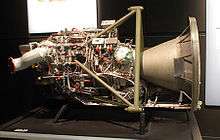Aerobee

The Aerobee rocket was a small (8 m) unguided suborbital sounding rocket used for high atmospheric and cosmic radiation research in the United States in the 1950s.[1]
Research utilizing V-2 rockets after World War II produced valuable results concerning the nature of cosmic rays, the solar spectrum, and the distribution of atmospheric ozone. The limited supply and the expense of assembling and firing the V-2 rockets led to the development of a low cost sounding rocket to be utilized for scientific research. This rocket, the Aerobee, was developed under the joint guidance of James Van Allen at the Applied Physics Laboratory and Rolf Sabersky at the Aerojet Corporation and was supported by the Navy Bureau of Ordnance and the Naval Office of Research and Inventions (later ONR). The Aerobee drastically reduced the cost of a single research mission.[2]
It was built by Aerojet General.[3] The company began work in 1946 and test fired the first complete Aerobee from the White Sands Proving Grounds in New Mexico on November 24, 1947. It reached an altitude of 34.7 miles (55.8 km).[4]
The rocket was two stage with a solid-fuel boost and a nitric acid/aniline sustainer. The rockets could reach around 230 km (a later variant exceeded 400 km). Instrumentation usually provided constant telemetry and was recovered by parachute. For accurate pointing special gimbal mounts were developed.
Aerobees were launched from 53 m tall launch towers to provide the necessary stability until the rockets gained enough speed for their fins to be effective in controlling attitude. Launch towers were built at White Sands Missile Range, Fort Churchill, Wallops Island, and aboard the research vessel USS Norton Sound. The Aerobee could take a 68 kg payload to an altitude of 130 km.
The first instrument-carrying Aerobee was the A-5, launched on March 5, 1948 from White Sands, carrying instruments for cosmic radiation research, reaching an altitude of 117.5 km. When the last Aerobee flew at White Sands in 1958, around 165 (including variants) had been successfully fired at that location. Variants of the Aerobee were launched in 1968 and 1969 for research relating to the Apollo program. The Aerojet engineers also developed the Aerobee-Hi (first launched in 1955).
A total of 1,037 Aerobees (including variants) were launched from all locations, the last on January 17, 1985.
Technical data
Aerobee
- Payload: 68 kg
- Maximum flight altitude: 130 km
- Liftoff Thrust: 18 kN
- Total Mass: 727 kg
- Core Diameter: 0.38 m
- Total Length: 7.80 m
Aerobee 75
- Maximum flight altitude: 80 km
- Liftoff Thrust: 7.00 kN
- Total Mass: 400 kg
- Total Length: 6.00 m

Aerobee 150
- Payload: 68 kg
- Maximum flight altitude: 270 km
- Liftoff Thrust: 18 kN
- Total Mass: 930 kg
- Core Diameter: 0.38 m
- Total Length: 9.30 m
Aerobee 170
- Maximum flight altitude: 200 km
- Liftoff Thrust: 225 kN
- Total Mass: 1,270 kg
- Core Diameter: 0.42 m
- Total Length: 12.60 m
Aerobee 170A
- Maximum flight altitude: 200 km
- Liftoff Thrust: 217 kN
- Total Mass: 1,270 kg
- Core Diameter: 0.42 m
- Total Length: 12.40 m
Aerobee 170B
- Maximum flight altitude: 200 km
- Liftoff Thrust: 225 kN
- Total Mass: 1,270 kg
- Core Diameter: 0.42 m
- Total Length: 12.40 m
Aerobee 200
- Maximum flight altitude: 250 km
- Liftoff Thrust: 225 kN
- Total Mass: 1,600 kg
- Core Diameter: 0.42 m
- Total Length: 12.60 m
Aerobee 300
- Payload: 45 kg
- Maximum flight altitude: 300 km
- Liftoff Thrust: 18 kN
- Total Mass: 983 kg
- Core Diameter: 0.38 m
- Total Length: 9.90 m
Aerobee 350
- Payload: 227 kg
- Maximum flight altitude: 450 km
- Liftoff Thrust: 217 kN
- Total Mass: 3,839 kg
- Core Diameter: 0.56 m
- Total Length: 15.90 m
- Span: 2.30 m
In fiction
In Men into Space, a 1960 tie-in novel by Murray Leinster for the TV series of the same name, Ed McCauley makes the first manned suborbital spaceflight in the nose-cone of an Aerobee.[5]
References
- ↑ "Archived copy". Archived from the original on 2013-05-16. Retrieved 2013-04-13.
- ↑ James Van Allen. "James Van Allen Papers". The University of Iowa Archives. Retrieved May 13, 2014.
- ↑ "Archived copy". Archived from the original on 2013-06-07. Retrieved 2013-04-13.
- ↑ "Area and Missile Range Chronology". WSMR. Archived from the original on 2007-11-17.
- ↑ Leinster, Murray (1960). Men into Space. New York: Berkley Publishing.
External links
| Wikimedia Commons has media related to Aerobee. |
